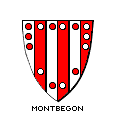
office (215)
233-4988
fax (000) 000-0000
Alt # (215) 000-0000
Brookfield Ancestor Project - Surety Barons
Magna Charta Baron Page
for
Roger De Montbegon
Lord of Horneby, Lancashire

Return to Barons at Runnymede Page
WURTS’ MAGNA CHARTA provided a brief accounting of the feudal headquarters of some of the Magna Charta Barons. Some of the castles have been badly damaged. Some have disappeared entirely. Often we can learn of them through Medieval and Renaissance accounts, and some of them require the discerning eye of the archeologist. Others await the evidence brought out with a shovel and pick, by the trained archeological historian.
A portion of the information concerning Surety Baron ROGER de MONTBEGON is as follows:
ROGER de MONTBEGON, the Surety, was the successor of Adam de Monte Begonis, whose principal lands were in Lincolnshire. Roger was apparently the son of this Adam by his wife Maud FitzSwaine. During the imprisonment of Richard I in Germany, Roger de Montbegon seems to have favored Prince John's designs on the throne, since he was one of those who held the Castle of Nottingham against the Bishop of Durham. When, however, the King on his return advanced to besiege that fortress, he came out and submitted himself without shooting an arrow. He was one of the most adamant in refusing to pay the levy assessed to those who did not supply the King with soldiers, and must have been more mercurial than most of the Barons. Whenever he was in one of his periodic lapses of disgrace, the King would reclaim some of the lands he had previously granted. In the Barons' proceedings to procure the Charter of Liberty from King John, he took a prominent part and was one of the parties to the covenant for surrendering the City and Tower of London into the hands of the Barons, although several lordships were granted or confirmed to him by King John as late as 1215/6. There is, however, no reason to doubt his original loyalty to the cause of the Barons for when he took up arms against the King, his possessions were seized and given to Oliver d'Albini, while he himself was excommunicated with the other Barons. Roger de Montbegon had no issue by his wife Olivia, whom he married about 1200, widow of Robert St. John. When he died in 1225/6 his Castle of Horneby in Lancashire was given by the King to John de Warren, Earl of Surrey; but when Henry de Montbegon became heir to Roger, he recovered it. Nevertheless Roger deserted the Barons before Magna Charta was confirmed a year and Roger de Mowbray was substituted for him among the Sureties. He was a younger brother of the Surety William de Mowbray. He did not marry and died in 1217/8, his elder brother William, succeeding to his estate. The armorial ensigns of Roger de Mowbray are extant in the South aisle of Westminster Abbey, as he was one of its benefactors.
Horneby Castle in Lancashire, now the seat of the Duke of Leeds, has not been of sufficient interest to warrant a description. On the other hand, Nottingham, the other Castle held by Roger de Montbegon, was once the key to the North. It now is overshadowed by a palatial combination museum and art gallery. It occupies a conspicuous site on a steep, rocky hill. The original remains include a restored Norman gateway and some few fragments of fortifications.
Nottingham Castle seems to owe its origin to the Danes, who are said to have erected a fort in 868. The later building was probably ordered by Edward the Elder. The rock motte evidently was not severed from the rest of the headland by a ditch until the Norman Castle was built, under the direction of William the Conqueror in 1067, when William returned, on the occasion of Yorkshire's first rebellion. Apparently realizing that this was the foremost midland fortress, he left William Peverel in command.
The two upper wards could have been suggested by William. The upper one forms a natural motte of rock, fifteen feet higher than the bailey attached to it. The keep has Norman buttresses. The North side of the small ward which formed the top of the motte was enclosed in a shell wall, no longer in existence. The Castle has been so changed by a 17th Century spoiler that the work of King Henry and King John is all gone, except for one small tower which seems to have been a part of the inner bailey defense system.
Appreciation is expressed to Reed M. W. Wurts, one of the Heralds of the Society for furnishing the Baron’s Shield on this page.
Return to Barons at Runnymede Page